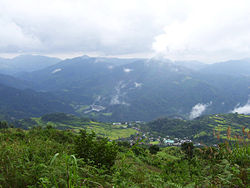Lubuagan, Kalinga
| Lubuagan | |
|---|---|
| Municipality | |
 |
|
 Map of Kalinga with Lubuagan highlighted |
|
| Location within the Philippines | |
| Coordinates: 17°21′N 121°11′E / 17.35°N 121.18°ECoordinates: 17°21′N 121°11′E / 17.35°N 121.18°E | |
| Country |
|
| Region | Cordillera Administrative Region (CAR) |
| Province | Kalinga |
| District | Lone District of Kalinga |
| Founded | 1905 |
| Barangays | 9 (see Barangays) |
| Government | |
| • Type | Sangguniang Bayan |
| • Mayor | Johnny "Abi" Agyao-Dickpus |
| • Electorate | 6,669 voters (2016) |
| Area | |
| • Total | 234.20 km2 (90.43 sq mi) |
| Population (2015 census) | |
| • Total | 8,733 |
| • Density | 37/km2 (97/sq mi) |
| Time zone | PST (UTC+8) |
| ZIP code | 3802 |
| PSGC | 143206000 |
| IDD : area code | +63 (0)74 |
| Income class | 4th municipal income class |
| Website | www |
Lubuagan, officially the Municipality of Lubuagan is a 4th class municipality in the province of Kalinga, Philippines. According to the 2015 census, it has a population of 8,733 people.
It is 460 kilometres (290 mi) north of Manila and 50 kilometres (31 mi) from Tabuk.
Lubuagan Municipality, once the seat of the National Government from March 6 to May 17, 1900, during the time of Gen. Emilio Aguinaldo, was among the eight (8) municipalities of the new province of Kalinga. It is located at 800 metres (2,600 ft) above sea level in the southern part of Kalinga and in the heart of the Cordillera. It has a land area of 23,420 hectares (57,900 acres). Some of its younger generation have migrated either in the lowland plains of Tabuk or in other provinces in search for income and employment opportunities.
Lubbuagan municipality has 9 barangays, as listed below with the 2010 census population shown in brackets.
Spanish Rule was never established in Lubuagan during the more than 300 years of sovereignty over the Philippines. However, President Emilio Aguinaldo, president of the erstwhile first Republic of the Philippines made Lubuagan the Capital of that first Republic for 72 days, from March 6 to May 17, 1900, before his escape and eventual capture at Palanan, Isabela, on March 23, 1901.
Upon the assumption of the United States of America as colonial power over the Philippines, the Township of Lubuagan, a unit of government at the time it was established in 1905 which was administered via the sub provincial government of Lepanto-Bontoc sub-province, Lt. Governor E. A. Eckman, an American ex-soldier was the Chief Executive of the sub-province.
Sometimes in 1907, Kalinga was separated and organized as a distinct sub-province from the Lepanto-Bontoc sub-province. Franklin Walter Hale was appointed the first Lt. Governor to establish a civil government in Kalinga.
Bulanao Barrio, a thriving big community of Tubog at the time, the site of which is the present homestead of Mr. Abe Umao was the target of Lt. Governor Hale as the center of this Administration of government in Kalinga sub-province. But shortly thereafter, the great cholera and malaria epidemic broke out in the later part of 1907 and continued in 1908 which almost wiped out the town populace. Lt. Governor Hales was himself attacked with malaria so that he and his official family were forced to leave Bulanao because those who survived the epidemic among the natives left.
...
Wikipedia

